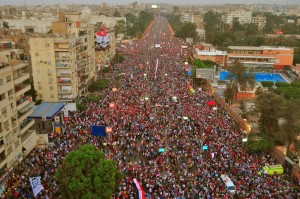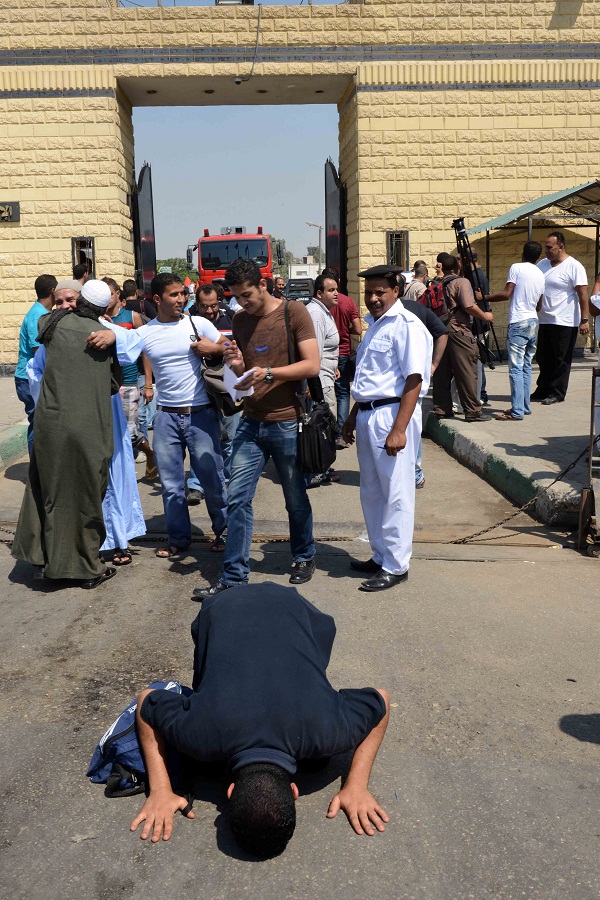
(Photo by Aaron T. Rose)
By Basil El-Dabh, Luiz Sanchez, Rana Muhammed Taha, Joel Gulhane, Nouran El-Behairy, Nourhan Dakroury, Mohammed Nagi, Rawan Ezzat
30 June witnessed an unprecedented mobilisation of demonstrations across Cairo, after a massive and coordinated signature campaign (Tamarod) calling for President Mohamed Morsi to leave office. So far the protests have reached at least seven governorates, with the Ministry of Health counting over 200 injured and a death in Beni Suef. Clashes ensued at the primary Muslim Brotherhood headquarters in Moqattam when a group attempted to set fire to the building, with Brotherhood defenders responding with birdshot.
Presidential palace marches
Marches from AL-Matariya, Al-Nour Mosque, Ghamra, and Al-Saa Square merged, leading tens, if not hundreds of thousands of protesters to the presidential palace, demanding the removal of the president. Many bystanders joined in with the chants as the march snaked through the streets.
Before the march began in Al-Saa Square, Mostafa Al Naggar, an opposition leader, read out rules for its participants. “Our march is free of any figureheads or any remnants of the fallen regime. Our march is to unify all Egyptians for one cause which is the early presidential elections. Whoever will deviate from those rules, we will deal with him personally,” proclaimed Al Naggar into a loud speaker.
In Al-Matariya neighbourhood, the crowds chanted “the people want the downfall of the Brotherhood,” as some held up images of sheep, an animal to which some critics of the Brotherhood liken its members and the president. Others held red cards and posters of Morsi’s face crossed out, and wrote Tamarod, or “Rebellion.”
A group of men held up a sign reading, “with Islam, against the Brotherhood,” while another held up a banner showing ousted President Hosni Mubarak, Field Marshall Mohamed Tantawi, and Morsi with nooses around their necks.
“We are coming to demand the removal of the president,” said protester Ahmed Ali. “[Morsi] has done nothing to fix this country and has betrayed it,” he added.
Mostafa Adel, one of the organisers, said, “We want this march to be peaceful. We are watching for any violence, and anyone who tries to create trouble will be kicked out.”
“There’s no petroleum, there’s no electricity, nothing was done in the past year” said protester Khaled Mohamed, “the Brotherhood tells us that we are attacking legitimacy, but I don’t see any legitmacy.”
The march from Al-Matariya arrived at the presidential palace at around 5.30pm, after merging with neighbouring marches from Ain Shams and other areas.
The area in front of the palace was blocked off, so most protesters were stuck either directly in front of the Heliopolis Sporting Club, or in several of the side streets that contained thousands of people.
Large waves of applause and cheers were heard whenever a military helicopter passed above the protesters, and people chanted “the people and the army are one hand”.
The Ultras Ahlawy, fans of Cairo-based Al-Ahly Club used fireworks and laser pens during the protest.
There was only one stage that was erected by Tamarod, and no other signs or logos other than the Egyptian flag were raised by people. Chants consisted only of Muslim Brotherhood, the revolution, and the downfall of the regime. Two of the most popular being, “Leave!” and “The people demand the downfall of the regime!”
As of this writing, demonstrations in Heliopolis had proceeded into Sunday night without incidents of violence. The perimeter of the palace was surrounded by protesters who said they would continue demonstrating until Morsi was removed.
The nationwide demonstrations against the president come one year after his inauguration. The Brotherhood, along with other Islamist groups, organised demonstrations and sit-ins “to defend legitimacy” at Rabaa Al-Adaweya in Nasr City.
Tahrir marches
Thousands of protesters meanwhile marched to Cairo’s iconic Tahrir Square, departing from various gathering points across town, including Mustafa Mahmoud Square in Mohandessin, Istiqama Mosque in Giza, and El-Gezira Club in Zamalek.
At Mustafa Mahmoud Square, Al-Dostour Party and National Salvation Front (NSF) leaders were among the marchers, the party stated, including leading NSF figure Amr Hamzawy and former Prime Minister Essam Sharaf.
Midway through the march, a group calling itself Elshaab Ureed distributed petitions among protesters, with the aim of delegating a presidential council of seven men to take over the state’s affairs from the president. The men included: Supreme Constitutional Court Chairman Adly Mansour, Grand Imam of Al-Azhar Ahmed Al-Tayeb, Defence Minister Abdul Fatah Al-Sisi, Al-Dostour Party founder Mohamed ElBaradei, constitutional expert and former Al-Dostour member Hossam Eissa, economic expert Ahmed Al Sayed Al Naggar and leftist leader Kamal Khalil. The petition stated that the council would be formed upon the approval of at least three of the suggested members to join.
At the march leaving from Giza’s Istiqama mosque, protesters carried Egyptian flags and chanted calls for Morsi to leave office.
As the march progressed, police officers in plainclothes and in uniform were cheered on as they drove through the crowds. Several officers atop the Giza police station also cheered as protesters marched past.
While many applauded the police’s decision to support the protest, some present expressed dismay at the praise. “How can people cheer the police and stand by them after everything they have done to the people; have they forgotten who the police are?!” demanded one protester.
The demonstration that left from El-Gezira Club in Zamalek, meanwhile, was filled from its outset with chants of “Leave,” “Down with the rule of the guide” and “Tomorrow we’ll paint on all walls, down with all sheep.”
As marches converged at Qasr Al-Nil Bridge in their approach to the square, the pace slowed to a near standstill, with the entrance to the square almost as crowded.
Inside the square, heavy crowds greatly restricted movement, with the entire roundabout and surrounding area mired with protesters. The large yard in front of Mogamma was completely covered with tents of different sizes and shapes, all with protesters camped outside.
A group of ambulances were lined at the sidelines of Omar Makram Mosque, and protesters stretched as far as the Simón Bolívar Square near the US embassy.
The 30 June nationwide protests were originally organised by the Tamarod movement, calling for the overthrow of Morsi and early presidential elections. The majority of chants, both in the marches and in the square, called on the president to leave office, with many protesters raising red cards against him.
“I came today because I don’t want [Brotherhood] rule anymore, and I will stay here [in Tahrir] until Morsi leaves,” said Maisa Gafar, one of the protesters, a sentiment echoed by a number of protesters, some of whom added they would be undeterred by the onset of Ramadan.
Heba Mohamed Mahmoud, a protester and mother of four, said that Morsi had done nothing for the country.
“People can’t find food and don’t have anything, they’re fed up,” Mahmoud said.
“A lot of businesses have had to close [since Morsi took office] and the country is penniless,” she added, accusing the Brotherhood of having loads of money while people remain in poverty.
“We will remain in the square until Morsi goes and is replaced by a real politician,” she said.



